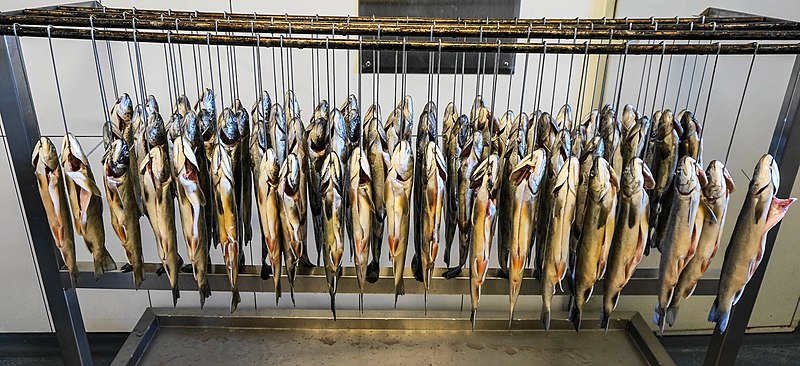Downloads:

General information
Salting and curing
Smoking
Keywords
Curing, salting, smoking, smoke, drying, preservation
Level
General information
Salting, curing and smoking are intended to preserve food for long periods of time. After applying each of the processes, the food maintains its color, texture and flavor, according to the methodology used. Traditionally, in the Mediterranean basin, curing and salting are applied to cheeses, pork and some fish such as cod, sardines or mackerel. Smoking, on the other hand, is used at the end of the process for making sausages with pork, poultry and game meat, as well as with certain individual food ingredients (e.g. salmon, bacon).
Salting and curing
Salting and curing can be part of the same process, and their distinction is determined by the amount of salt and the time the food is exposed to salt, a substance that inhibits the natural degradation processes that generate the appearance of bacteria and microorganisms. Salt makes the water present in the food to be released, balancing electrolytes (sodium, chloride) inside and outside the food.
Salting is also a way of curing. It essentially consists of wrapping the food with dry salt or in a liquid with salt and other substances, such as aromatic herbs (link to the picking and brining fiche).
Curing takes place by adding a mixture of substances to the food, including salt, sugar, flavor enhancers, among others. Some factors that influence the curing of a food are size (the larger, the longer it takes to cure), temperature (the higher, the faster it takes to cure), moisture content, salt concentration in the food, dry or wet mixture (the more salt, the faster it takes to cure), and amount of fat (the fatter, the slower it takes to cure). This process, namely with meat, requires the presence of nitrates and nitrites (forms of salt) to inhibit or slow the growth of pathogenic bacteria, such as clostridium botulinum
Smoking
As with curing, smoking also needs nitrates and nitrites. The origins of smoking go back to the discovery of fire. Smoking a food consists of exposing it to the smoke produced by the incomplete combustion of wood. The conservation obtained from the action of smoke results from the bacteriostatic effect it exerts on microorganisms. Burning wood promotes a superficial dehydration of the food, creating a protective layer and increasing its shelf life. Furthermore, smoking can delay the oxidation of fats, improve the organoleptic properties of the food, and provide aroma and color, so characteristic of smoked products.
Traditionally, in the Mediterranean basin, ham and sausages were prepared when the animal is killed, namely pigs, and smoked by the fireplace (the smokehouse) for several weeks. The gut of the animal is still used as the external casing in the preparation of traditional sausages. This process normally occurs during winter and so it is called cold smoking, as there is a slow circulation of smoke, resulting in products with a smoother texture, but with a shelf life shorter than that of industrially smoked products. Hot smoking, where the food is cooked, results in more textured and drier products, although the interior can be just as smooth, depending on the fat content, its distribution, and the amount of water the food contains.
Cured and smoked products, with many varieties, are consumed all year round in Mediterranean countries, especially in social occasions.
Description
Salting, curing and smoking are intended to preserve food for long periods of time. After applying each of the processes, the food maintains its color, texture and flavor, according to the methodology used. Traditionally, in the Mediterranean basin, curing and salting are applied to cheeses, pork and some fish such as cod, sardines or mackerel. Smoking, on the other hand, is used at the end of the process for making sausages with pork, poultry and game meat, as well as with certain individual food ingredients (e.g. salmon, bacon).
Labels
Benefits
The salting, curing and smoking processes help to extend the shelf life of the food. On the other hand, they enhance the flavor of some food ingredients and the surprising emergence of new flavors, aromas, and even colors.
The techniques of curing and smoking allow for products to be ready for consumption, without the need for additional preparation, although they are often grilled, fried or roasted.
The smoking technique is often associated with processes that are based on the total use of the food/animal, namely meat for production of sausages, thus contributing to fight food waste.
As these products are usually rich in salt and contain fatty ingredients, their consumption should be moderate.
Representative Products
Salting: fish (cod, herring, anchovy), meat (bacon).
Curing: fish (tuna), meat, goat cheese, sheep and beef.
Fish: salmon, mackerel, blue mackerel, swordfish, trout.
Meat: charcuterie and sausages (several varieties of ham and sausages).
Cheese: provolone.
Risks
These techniques imply high quantities of salt and are applied to fatty products. Therefore, a frugal consumption of these products is advised, since salt is associated to diseases such as cholesterol and high blood pressure.
Curing and smoking involves the presence of nitrates and nitrites, since they have a relevant paper in the fight against clostridium botulinum (by reducing the pH). However, the level of salt required for these techniques advises a moderate intake of cured and smoked products.
Best practices indicate:
- Appropriate storing temperature;
- Good hygiene of containers;
- Checking food integrity before applying salting, curing or smoking methods to avoid microbiological deterioration.
Further references
https://www.acsedu.co.uk/Info/Alternative-Living/Self-Sufficiency/Salting-Food.aspx
https://nchfp.uga.edu/publications/nchfp/lit_rev/cure_smoke_cure.html
https://www.canr.msu.edu/news/smoking_as_a_food_cooking_method
https://fyi.extension.wisc.edu/meats/files/2012/02/Nitrate-and-nitrite-in-cured-meat_10-18-2012.pdf
 Play Audio
Play Audio

